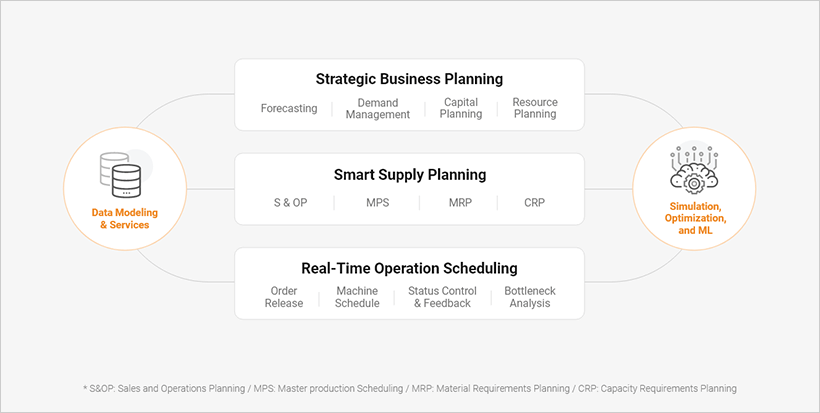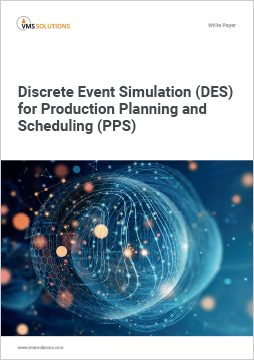Discrete Event Simulation (DES) for Production Planning and Scheduling (PPS)
January 12, 2023
Even beyond the influence of Industry 4.0, there is much interest in digital twins in manufacturing industries around the world. The concept of digital twins involves using simulation modeling to create a virtual factory that is equivalent to the actual factory, experiment with various scenarios targeting virtual factories, analyze and compare the results, and apply the proven alternative in the actual factory.
In simulation modeling, modeling techniques and level of detail vary depending on the purpose. This article focuses on simulation models for production planning and scheduling in manufacturing companies using VMS simulation product, MOZART Loading Simulation Engine (LSE). As indicated in Figure 1, a production operation system has various modules determined by the business layer structure. One must first create an integrated simulation model with data that each layer application may share. Based on this data model, the desired application can be built by adding functions specific to each module. In addition, the simulation model is utilized as a basic tool to increase production operation efficiency by combining optimization and artificial intelligence/machine learning (AI/ML) technologies.

Figure 1: Production Planning and Scheduling Modules (source: https://vms-solutions.com/)
Discrete event simulation (DES) is effective for modeling the behavior of jobs and resources in terms of production planning
Discrete event simulation (DES) is a very suitable method for analyzing the behavior of a production system from a planning and scheduling perspective. In DES, the meaning of the words “event” and “discrete” are important. First, a finite number of “events” are defined in the target system. When an event occurs, it triggers its processing function, which is predefined to process the event accordingly. For example, when an event in which a machine finishes processing a job occurs, the next job is evaluated and selected from the waiting jobs. The word “discrete” captures how the pattern of occurrence of events occurs discontinuously rather than continuously. The occurrence interval between events may be random or defined by a rule. Once a machine starts processing a job, a “process complete” event occurs after a predetermined processing time.
Production Simulation Using MOZART Loading Simulation Engine (LSE)
DES can simulate how products flow in a real factory by focusing the modeling on the resource loading/unloading events. The two key objects in production simulation are jobs and resources. The user defines a dispatching rule in which the resource selects one of the waiting jobs according to its priority, and the simulation engine handles discrete event processing.
The simulation model is also composed of two objects. The bill of process (BOP) model defines the products and the processes required to make each product, while the resource model defines the processing behavior of the machine. In addition, the processing rules and constraints for job processing on the resource such as job change rules are defined.
Conclusion
DES is a good method for modeling and analyzing a manufacturing operation to produce planning and scheduling systems. It can handle most rules and constraints that the manufacturing operation team or planners may consider. Since decisions are usually made concerning specific events, the user can easily create the simulation model by defining events and processing function logic. The simulation results produce reason codes to explain each decision, which helps the user understand the system and accelerate analysis and continuous improvement.
Learn more: Resource Download



